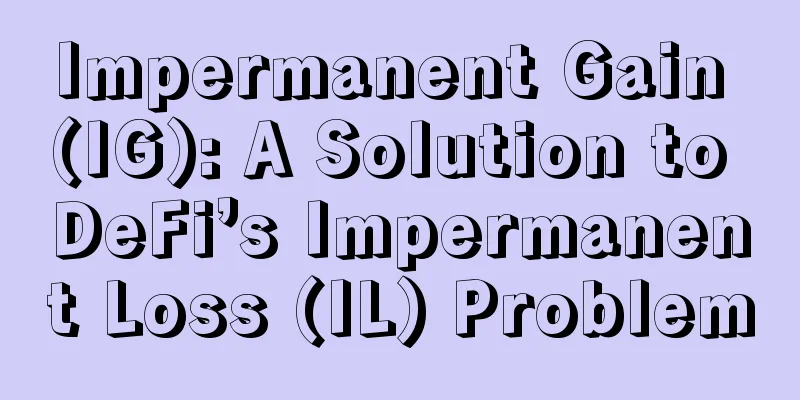Impermanent Gain (IG): A Solution to DeFi’s Impermanent Loss (IL) Problem

|
Note: The original author is DeFi developer Ping Chen. In this article, he proposed the concept of impermanent return (IG), which is a solution to the DeFi impermanent loss (IL) problem. He believes that impermanent return (IG) is applicable to all AMM liquidity providers. Automated Market Makers (AMMs) and Impermanent Loss (IL)In the field of automated market makers (AMMs), the issue of impermanent loss (IL) has been discussed for a long time. By definition, Impermanent Loss (IL) is the "extra" loss compared to holding the same position, and is not related to the capital PnL. People call this loss "impermanent" mainly because most AMMs are path-independent, which means that if the price changes and returns to the original position, then this Impermanent Loss (IL) disappears. ( Claiming that you have the ultimate solution to impermanent loss is like claiming to have invented a perpetual motion machine. People should laugh at you loudly. ) Unsolvable ProblemsThe essence of becoming an AMM liquidity provider is MM (i.e. market maker). Market making is a trading strategy that creates profits by placing buy and sell orders and obtaining the spread. Unlike going long or short, the MM strategy makes profits when the market is stable. Many new AMM projects claim to have solved the impermanent loss (IL) problem by introducing oracles, custom weights, delayed transactions, etc. These methods may mitigate impermanent loss in certain specific cases, but it is impossible to become a liquidity provider without taking risks. There is no free lunch in the world. If you can't kill it, embrace itRather than 100% eliminating impermanent loss, we propose an alternative approach to the problem: a synthetic, tokenized impermanent loss hedge position. We call it IG, which stands for impermanent return. When holding 1 IG, it perfectly offsets the impermanent loss IL of holding a 1 USD LP position. It can be said that IG is the antimatter of IL. People can buy IG to hedge their risk as a liquidity provider (LP) or simply for speculative purposes. Liquidity providers (LPs) like impermanent returns (IG)Considering that there are some external motivations (liquidity mining) to become a liquidity provider (LP) today, impermanent return (IG) may become a game changer for DeFi. Assuming you want to provide liquidity for the ETH-DAI pair on Uniswap to earn UNI tokens, your return would be: Transaction Fees + Mining Rewards + Capital PnL - Impermanent Loss (IL) With impermanent return (IG), the return becomes: Transaction Fees + Mining Rewards + Capital PnL-IG Fees Overall, this is more stable and predictable. If you are very risk-averse, you can short ETH and lock in fiat gains, and the return is: Transaction fee + mining reward - short selling fee - IG fee Impermanent Income (IG) System DesignMinting/burning/trading impermanent income (IG) We use a prediction market-like approach to create the Impermanent Return (IG) token, and have a built-in secondary market. Anyone can provide liquidity for "a" and "b" to earn fees. When a user deposits 1 USD into the system, they will receive 1 a token + 1 b token, where the “b” token represents the capitalized asset IG, and the “a” token is its counterpart, which is worth 1-b. Users can exchange "a" and "b" with the liquidity pool Or they can buy or sell "a" and "b" separately. The system gets price data from the oracle from the beginning, and when the cycle ends, it automatically calculates the price change IG and settles the value of the "a" and "b" tokens. Finally, users can close their positions and withdraw their funds. Pricing IndicatorsIG is an open platform, which means anyone can mint, burn, trade, and provide liquidity. Holding a "b" token means you are long IG. On the other hand, holding an "a" token is like selling a call option to someone else, thereby earning a possible fee. I collected daily price data for ETH and drafted a fundamental analysis report: https://pastebin.com/gDU4cHQM It includes daily prices, 30-day price changes, and the impermanent loss (IL) of the past 12 months. The results show that the average monthly impermanent loss (IL) is surprisingly low, only about 1.18%, and the highest is 8.8%, which is not too outrageous. From the data above, it might be a good idea to start by selling the “b” token at $0.027, which would give you a win rate of about 84%. At present, there are two problems to be solved. The first problem is capital efficiency, which can be improved by introducing a "leverage" factor to change the return of the "b" token. The second issue is liquidity. As long as IG is a quarterly option, its price may fluctuate and decay over time. However, this is not good for liquidity providers (LPs), not to mention the "IL of IL" problem... In order to protect liquidity providers, we will need external incentives or high spreads. Below is the IG contract code. It is still immature and needs more efforts to improve. https://github.com/artistic709/ImpermanentGain/blob/main/ImpermanentGain.sol Link to this article: https://www.8btc.com/article/658730 |
Recommend
Is the fate of a woman with dimples good?
1. Good looks In today's world, if a girl is ...
Under heavy regulatory pressure, asset management giant BlackRock submits application for spot Bitcoin ETF
According to a public document, on the afternoon ...
People with a strong sense of vanity in life
Sometimes, vanity is really an undesirable qualit...
Cryptocurrency mining impacts AMD stock, Nvidia overestimates GPU demand
Demand from cryptocurrency companies has indirect...
Physiognomy teaches you how to identify the sex of the fetus
In Chinese physiognomy, there are many ways to te...
The characteristics of a wealthy woman
Different facial features have different fortunes...
How is the fortune of a woman born under the element of Chaichuanjin if she has a mole that makes her cry for her husband?
If a woman with the Chaichuanjin element has a mo...
What does a mole on the palm mean? Is the mole on the palm good?
Everyone has moles on their body, and the sizes a...
Crypto tax amendment fails to pass unanimously in Senate
The U.S. Senate on Monday rejected a tax amendmen...
Is it good fortune to have a mole on the bridge of nose? What does it represent?
Everyone hopes that they have good fortune in wea...
The 90th Bitcoin obituary: Xapo CEO gambles $250,000
Recently, the Washington Post published an articl...
G7 leaders release guidelines for central bank digital currencies
The G7 finance leaders agreed that CBDCs would co...
Analysis of the facial features of a person with impulsive personality but strong loyalty
What do knife-shaped eyebrows look like? Broadswo...
What does a mole in the center of the forehead mean?
In physiognomy, the forehead is called the palace...
Can you tell wealth and fortune from a woman’s palm reading? Is your fortune rich or noble?
If a woman is destined to be rich, she will defin...









